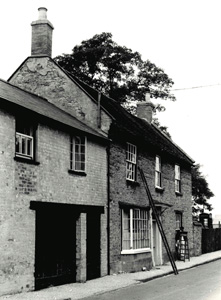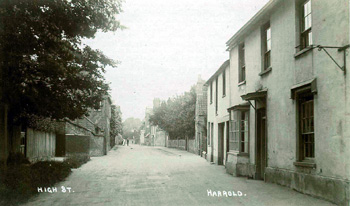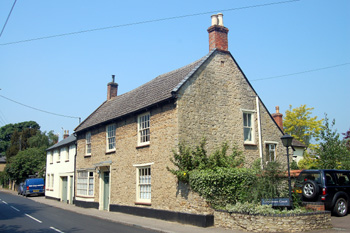Greystones 24 High Street Harrold

Greystones Guest House in 1962 [ref: Z53/54/23]
This building was listed by the former Department of Environment as Grade II (of special interest). It is dated 1817, is built of coursed stone rubble and has two storeys.
The date of 1817 is interesting. In the latter half of the 20th century the then owners bought in the deeds to the property to Bedfordshire Archives. They were studied and catalogued before being returned. The catalogue is CRT130Harrold9 and gives a history as set out below.
In 1702 William Woolston of Harrold, yeoman, sold a cottage and 1 acre 1 rood of "every year's land" adjoining with the Queen's Highway on one side and a common footway on the other to his eldest son John Woolston for £11 with a covenant that he had a chimney built onto the house so that William and his wife, Helen, could live in it free of rent.
In 1777 Charles Woolston of Bedford, cordwainer, great grandson of John, and his wife, Mary conveyed a cottage "now divided into two dwellings", with one acre one rood, in occupation of Richard Smith and William Cox to Edward Abraham of Harrold, lace merchant, for £125. Then in 1793 Abraham sold it to William Wootton of Harrold, lace merchant. The cottage was now divided into three and in occupation of Joseph Moore, Ephraim Smith and Thomas Parker, he also sold the one acre one rood adjoining it and in his own occupation. Abraham also sold a cottage, "heretofore called Vintree House" which bordered the common street to the south and the brook to the north [this may be 114 High Street, The Vines]. The two cottages and the land totalled £450.
William Wootton died in 1807 and left the property to his son William, described as "gentleman". In 1809 William Wootton junior sold three messuages with two barns and a garden adjoining [in other words the cottage of 1702 and at least some of the one acre, one rood of land], in occupation of Thomas Parker, John Pratt and Joseph Moore to William Luddington of Harrold, cordwainer, for £60.
In 1841 William Luddington, and his wife Mary, conveyed what later became Greystones to Rev.Montague James Taylor of Harrold, clerk [the vicar]. A recital in the conveyance noted that William Luddington had "many years since" pulled down the three cottages in one, "or the greater part thereof" and built a new house on the site. Thus a date for Greystones of 1817.
Then, in 1849 Robert Richard Allen of Harrold, shoe manufacturer, bought the following four pieces of property from Rev.Taylor, now no longer the vicar:
- a messuage erected where three messuages stood, with a barn and yard adjoining [i.e. Greystones];
- a piece of garden on the east side of the property above;
- two newly erected cottages built by Taylor on the site of barns adjoining the messuage on the north side;
- two newly erected barns or coach houses built by Taylor on the north side of the garden and fronting south on the highway.
Allen later, in 1862, also bought two cottages and adjoining ground from William Wootton of Harrold, surgeon [perhaps this was more of the one acre, one rood of land, now built upon] for £50. He took them down and turned them into a garden. Allen over-reached himself, however, and in 1864 had to assign all his real estate and personal property to Hugh Sanders of Odell, farmer, Caleb Fever [leFevre] of Harrold, farmer and John Goff of Harrold, farmer and grazier, three of his creditors, to act as trustees on behalf of all the creditors. They sold the house which would become Greystones along with a granary newly erected on part of the garden, the two newly erected cottages and barns to Charles Brookes of Fletton [Huntingdonshire], gentleman for £405.
In 1871 Brookes, still of Fletton, conveyed all the property he had bought from Allen's trustees to Louisa Anne Allen and Julia Mary Allen of Harrold for £105, subject to a mortgage of £300. The 1861 census reveals that they were Robert Allen's daughters, then in their twenties, obviously buying back their inheritance! However, seven years later Louisa Anne and her sister, now Julia Mary Clarke of Malmesbury [Wiltshire], widow conveyed the property to George Claridge, late of Carlton, farmer, now of Harrold, gentleman, to whom the £300 mortgage was owed, for £500 - thus making £95 profit.
George Claridge died in 1882 and his executors conveyed the property to Martha Fairey of Harrold, widow, that same year for £430. She died in 1892 and left the property in her will to her son Thomas John Fairey. He died intestate in 1900 and letters of administration of his property were granted to his widow Amy Eliza in 1901.

Greystones House and High Street about 1920
In 1920 the property later called Greystones, then described as a messuage in the High Street, with yards, gardens and outbuildings bounded north by a public footpath, west by property of William Peach, south by the High Street and east by property of Higgins & Sons Limited, along with a right of way through a gateway in the wall on the common footpath, was conveyed by Vincent Cyril Fairey of Harrold, clerk and Amy Eliza Fairey of Harrold, widow to Albert Clayson of Harrold, builder.
In 1927 property in Harrold was valued under the Rating & Valuation Act of 1925; every piece of land and building in the country had to be valued to determine the rates to be paid upon it. The valuer visiting Greystones [ref: DV1/C71/67-68] noted that it was owned and occupied by Albert Clayson and stood in 0.170 acres. It comprised two reception rooms, a kitchen, scullery, office and wc downstairs; five bedrooms lay above. Outside were a "good entrance" and "at the back" a brick and slate paint store with a loft over, a fuel house, a cement store with a loft over. The valuer noted "good garden water pumped" but then remarked: "A very unattractive house - right on road but plenty of room inside". Just to underline his point he then added: "Most unattractive".
In October 1927 Albert Clayson sold this "most unattractive" building to Miss Alice Mary Underwood of Welford [Northamptonshire]. She died on 5th June 1938 and her executors conveyed the property to Squadron Leader H.J.A.Williams of Mowhills, Harrold in 1940. Then, in 1961, the property "known as Greystones" was conveyed by H.J.A.Williams to Isabella Hunter Vance of London W14, after which it became a guest house for a while.

24 High Street - Greystones, May 2008